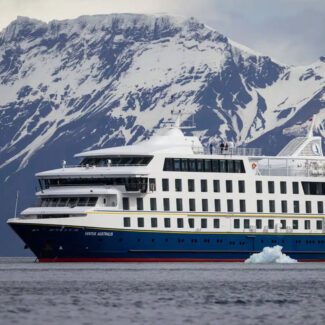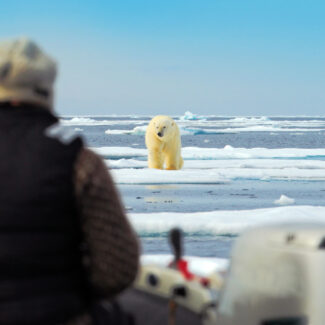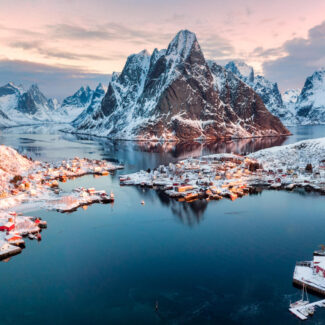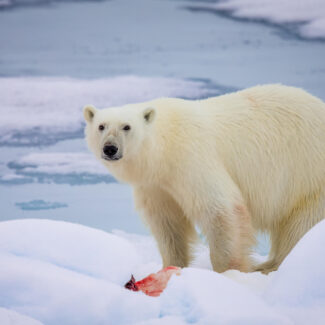Antarctica Weather: Climate, Seasons, Winds & Temperatures
- The Superlative Climate of Antarctica
- The Cold of the White Continent
- Antarctica Precipitation
- Antarctica’s Ice Cap Climate
- The Tundra Climate of the Antarctic Peninsula
- Antarctica Winds
- Does Antarctica Have Seasons?
- Weather & Climate on the Antarctic Peninsula & Sub-Antarctic Islands
- The Capriciousness of Weather in Antarctica
Antarctica’s cold—everybody knows that. But the ins-and-outs of Antarctica’s climate are fascinating to parse out, given just how extreme it is. Indeed, getting even a little taste for the polar weather—albeit, for most visitors anyway, during the warmest time of year in the White Continent’s mildest regions—is part of the thrill of a trip here.
In this article, we’ll explore Antarctica’s weather and climate with broad strokes, and provide a snapshot of the temperatures one can expect in a couple of the most frequently visited parts of the Antarctic.
The Superlative Climate of Antarctica
Antarctica is a realm of extremes: not only the coldest of the continents, but also the driest and the windiest. That’s right: the driest. Most of Antarctica is a polar desert, with much of the continent classified as hyper-arid.
The Cold of the White Continent
We’ll get into why Antarctica’s so dry—and note which parts of the continent are a bit wetter—shortly, but first we need to establish why it’s so frigid, given they’re related factors. The average temperature in Antarctica varies from -10 °Celsius (14 °F) along the coastline to -60 °C (-76 °F) in the deepest interior.
Because it lies at extremely high latitude, Antarctica receives lower-angle, and thus less intense, sunlight, with consequently more spread-out solar insolation and lower received heat energy. And that’s when the sun’s even showing up: In the depths of winter south of the Antarctic Circle, there are extended periods when our home star doesn’t get above the horizon, with six months of darkness at the actual South Pole.
Furthermore, Antarctica’s landmass comes piled deep in ice, which raises its average elevation to the loftiest of any continent: some 7,200 feet above sea level. So Antarctica’s deep chill is enhanced not only by its high-latitude position, but by its high elevation. Antarctica’s blanket of ice and snow also reflects most of the incoming sunlight, meaning the ground soaks up little solar radiation.
On the other side of the planet, the Arctic—also, of course, plenty cold—has a less-severe climate thanks to the moderating effect of its Arctic Ocean seawater. Antarctica’s vast continental extent means the surrounding Southern Ocean has less influence on temperatures, especially in the interior. Additionally, the dramatic winter expansion of sea ice around Antarctica pushes the coastal fringe—and the warming effect of the ocean—even farther from the continental landmass.
The Transantarctic Mountain Range, a majestic spine of rock and ice, beautifully illustrates the profound cold that defines the White Continent. These formidable peaks, carved by relentless icy winds, stand as a stark reminder of Antarctica’s extreme temperatures and its unparalleled, frozen grandeur.
Antarctica Precipitation
Antarctica’s low temperatures also explain its dryness, as cold air can’t hold as much water vapor. Indeed, this is something of a vicious cycle: Water vapor is an important absorber of heat, so the White Continent’s very dry atmosphere doesn’t capture or retain much of the radiative heat emitted from the ground, enhancing the cold. As we’ve already established, therefore, much of Antarctica is a legitimate desert, although coastal areas get more precipitation. The famous McMurdo Dry Valleys don’t appear to receive much of any precipitation at all—a pattern that’s perhaps been underway for a couple of million years, making these barren chasms perhaps the world’s driest place.
Some rain falls in summer on the Antarctic Peninsula and other coastal zones, but Antarctica’s precipitation is, unsurprisingly, generally of the frozen variety. Polar desert snowfall amounts aren’t impressive, especially over the interior, where the parched, subzero conditions mean the sparse precipitation often falls as ice crystal: the “diamond dust” that commonly forms halos amid the blazing ice-sheet sunshine. Given the prevailing cold, though, most fallen snow doesn’t melt. Its year-by-year buildup and compaction across the eons explains the existence of the Antarctic ice sheet.
Roughly considering the liquid-water equivalent of Antarctica’s mostly frozen precipitation, the average rainfall in Antarctica, continent-wide, shakes out to something like 150 millimeters (6 in.), according to the Australian Antarctic Program. The wetter coastal zone often gets more than 200 millimeters (7.8 in.) per year, but large tracts of the Antarctic Polar Plateau dominating the continental interior see less than 50 millimeters (2 in.) annually.
Despite its vast ice sheets, Antarctica is technically a desert due to very low precipitation. This image, showing a kayaker amidst light snowfall and ice, beautifully illustrates the subtle forms of precipitation that do occur, contributing to the continent’s stunning, yet arid, icy landscapes.
Antarctica’s Ice Cap Climate
These severe conditions mean that nearly all of Antarctica falls under the classification of an ice cap climate. The only other extensive expression of that climate zone on Earth is the Greenland ice sheet in the Northern Hemisphere. In Antarctica, the mean temperature falls below freezing every month of the year, though the continent’s coastal margins, and especially the Antarctic Peninsula, are milder than the interior.
The White Continent’s most fearsome weather is found on the high plateau of the East Antarctic Ice Sheet. Much of this Polar Plateau lies above 10,000 feet with monthly temperatures averaging between about -20 °C (-4 °F) and -60 °C (-76 °F). The most frigid temperature ever measured on Earth was recorded on the East Antarctic Ice Sheet between the two summits Dome Argus and Dome Fuji, which reached -93.2 °C (-136 °F) on August 10, 2010, beating the previous record of -88 °C (-130 °F) taken on July 21, 1983 at Vostok Station. But an ice height on the Polar Plateau called Ridge A may be the all-around coldest place in the world, with an average annual temperature of -70 °C (-94 °F).
Experience the formidable “ice cap climate” that defines much of Antarctica, especially its interior. Characterized by extreme cold and endless ice, this environment, though harsh, is home to resilient wildlife like the Emperor penguin shown here, a testament to life’s adaptability in the planet’s iciest reaches.
The Tundra Climate of the Antarctic Peninsula
By comparison, the Antarctic Peninsula—where the bulk of Antarctica tourism proceeds—is downright balmy. That’s partly because it extends farther north than other parts of the continent, past the Antarctic Circle. (A few small areas on the East Antarctic coast also nudge past this circle of latitude defining the northern limit of the Antarctic proper.) It’s also because the Peninsula is a narrow finger of land (and ice) mostly surrounded by water, which adds a strong maritime influence to its climate, especially in its northern section.
Indeed, much of the Antarctic Peninsula escapes the severe classification of an ice cap climate and falls instead within the tundra climate prevailing in the sub-Antarctic islands and parts of Tierra del Fuego. The long, cold winters of the Antarctic Peninsula are not so brutal as elsewhere on the continent, with mean monthly temperatures around -12 °C (10.4 °F), and meanwhile summer highs can soar above 10 °C (50 °F)—in fact the highest temperature on the Antarctic mainland was 18.3 °C (64.9 °F) at Esperanza Base (Argentina) on 6 February 2020. The warmer air and oceanic moisture also explains the Antarctic Peninsula’s higher precipitation, with the coastline of the Bellingshausen Sea on the west side—the warmer, most maritime-influenced side, as compared to the more continental Weddell Sea coast—receiving more than 1,000 mm (39 in) a year.
Esperanza Base, nestled on the Antarctic Peninsula, perfectly showcases the region’s distinctive tundra climate. Even with its chilly temperatures and strong winds, this landscape reveals surprising patches of rock and minimal snow in certain areas, providing a unique glimpse into the less extreme, yet still formidable, conditions of this polar region.
Antarctica Winds
Wind defines Antarctica nearly as much as cold. That’s especially true along the coastal margins. The paramount wind here is a variety known as a katabatic wind, which is a function of cold air being denser than warm air. Deep-chilled air pools atop the iced-over Polar Plateau, then spills downslope, sometimes gaining wicked speed off mountainsides and ice shelves: an Antarctica phenomenon familiar to many researchers at coastal stations.
The average wind speed in Antarctica is only about 14 miles per hour (12 knots). That’s because winds over the heights of the ice sheet are quite modest, averaging about 9 mph (8 knots) to 17 mph (15 knots) at the South Pole. The strongest wind recorded there was a mere 58 mph (50 knots).
But katabatic winds pouring off the ice sheet make the coastal zone of Antarctica much more blustery. Cape Denison along Commonwealth Bay boasts the highest average annual wind speed in the world: 44 mph (38 knots). Winds above 100 mph are not unusual in Antarctica. On December 9, 1960, for instance, katabatic gusts of 140 to 155 mph (122 to 135 knots) ruined an aircraft at Mawson Station on the MacRobertson Land coast of East Antarctica. The highest wind speed registered in Antarctica was a monstrous 199 mph (173 knots) at Dumont d’Urville Station on the Adélie Coast, measured in the austral winter of 1972.
While outside the Antarctic proper, it’s worth noting that many visitors to the White Continent experience another zone of often-epic windiness via the Drake Passage, the waterway crossed on sails between Tierra del Fuego and the South Shetland Islands. This falls within the strong east-flowing winds of the Southern Ocean, which unlike in the analogous band of westerlies in the Northern Hemisphere aren’t slowed and warped by extensive landmasses. These Southern Ocean westerlies strengthen southward, explaining the maritime nicknames for the according latitudes: the Roaring Forties, Furious Fifties, and Screaming Sixties.
Antarctica is famous for its fierce winds, which can whip up stunning, yet challenging, blizzards. This image of a resilient Gentoo penguin weathering the elements perfectly illustrates the powerful atmospheric forces at play across the continent, reminding us of the raw, untamed beauty of its climate.
Does Antarctica Have Seasons?
Antarctica’s polar climate is a two-season one, oscillating between the frigid darkness of winter between April and October, and the still-rather-frigid, sun-blasted summer from November to March. This is most extremely represented by the South Pole, where the “Midnight Sun” of summer provides 24 hours of daylight for several months, while darkness prevails during a long stretch of winter. The duration of 24-hour summer daylight and winter night decrease northward toward the Antarctic Circle. The Australian Antarctic Program’s website provides useful graphs depicting sunlight hours across the year for different locations in the Antarctic.
While summer and winter are the “true” Antarctic seasons, you’ll often hear talk of spring (considered to be late September to early November) and fall (roughly late February to early April) on the White Continent, referring to the transitional periods between. Naturally, the main variables are increasing and decreasing shares of daylight and, slightly lagging behind, rising and falling temperatures, respectively. The according retreat and expansion of sea ice helps establish the rhythm of the Antarctic year. Ice diminishes through the warm season to a seasonal minimum usually in March, with mid- and late-summer visitors typically benefitting from maximum access along the continental margin.
Yes, Antarctica absolutely has seasons, defined by dramatic shifts in daylight! During the austral summer, visitors experience the surreal “Midnight Sun,” where the sun never fully sets, casting incredible long-lasting golden hues over the icy landscape, making for truly unforgettable and extended days of exploration.
Weather & Climate on the Antarctic Peninsula & Sub-Antarctic Islands
While some cruises and fly-ins penetrate deeper into the White Continent, most sightseers experience Antarctica by visiting the Antarctic Peninsula. Many cruises out of South America also take in the scenic and wildlife pleasures of the sub-Antarctic paradise of South Georgia. As such, it’s worth highlighting the general climate and month-by-month weather of these popular destinations.
The Antarctic Peninsula’s Climate
- Fairly typical maritime climate, cold winter and warmer summers.
- The western side of the Peninsula is warmer than the eastern side.
- Cold winters and short cold summers, approx. -12.6 °C to +1.0 °C (9.3 °F to 33.8 °F) monthly averages
- Depressions come in from the west bringing cloud precipitation and winds, rain frequently falls in summer
- Annual average temperature -5.3°C (22.5 °F), range 13.6 °C (24.5 °F)
Jan: 1.0 °C (33.8 °F)
Feb: 0.1 °C (32.2 °F)
Mar: -1.6 °C (29.1 °F)
Apr: -3.7 °C (25.3 °F)
May: -6.8 °C (19.8 °F)
Jun: -8.8 °C (16.1 °F)
Jul: -12.6 °C (9.3 °F)
Aug: -11.8 °C (10.8 °F)
Sep: -9.4 °C (15.1 °F)
Oct: -7.2 °C (19.0 °F)
Nov: -3.3 °C (26.0 °F)
Dec: 0.2 °C (32.4 °F)
(Temperature data taken from Rothera Research Station on Adelaide Island along the Antarctic Peninsula)
The Palmer Archipelago, part of the Antarctic Peninsula, exemplifies the region’s milder, maritime climate. Here, you’ll encounter breathtaking tabular icebergs like this one, sculpted by the unique weather patterns that distinguish the Peninsula from the continent’s interior, making it a prime destination for exploration.
South Georgia’s Climate
- Oceanic climate with cool summers and similar but cooler winters, approx. -1.5 °C to +5.4 °C (29.3 °F to 41.7 °F) monthly averages
- Depressions bring rain in summer, snow in winter and strong winds year-round
- Annual average temperature 1.8 °C (35.2 °F) , range 6.9 °C (12.4 °F)
Jan: 4.7 °C (40.5 °F)
Feb: 5.4 °C (41.7 °F)
Mar: 4.6 °C (40.3 °F)
Apr: 2.5 °C (36.5 °F)
May: 0.2 °C (32.4 °F)
Jun: -1.5 °C (29.3 °F)
Jul: -1.5 °C (29.3 °F)
Aug: -1.5 °C (29.3 °F)
Sep: 0.1 °C (32.2 °F)
Oct: 0.7 °C (33.3 °F)
Nov: 3.0 °C (37.4 °F)
Dec: 3.8 °C (38.8 °F)
(Temperature data taken from Grytviken on the sub-Antarctic island of South Georgia)
South Georgia boasts a sub-Antarctic climate that, while still cool, is significantly milder than the continent itself, allowing for incredible wildlife populations. The sheer number of King penguins thriving here is a testament to this unique climate, where slightly warmer temperatures foster one of the world’s most impressive wildlife spectacles.
The Capriciousness of Weather in Antarctica
We’ve covered a lot of the overall climatic elements that shape the White Continent. It’s worth noting, though, that Antarctica weather—the day-to-day goings-on of the polar atmosphere, playing out against the broader seasonal cycles and long-term oscillations and trends of climate—can be unpredictable.
In fact, the only thing you can predict about Antarctica’s weather is that it is certain to be wholly unpredictable. During a summer “heatwave” along the Antarctic Peninsula, you may wonder whether you’re actually down at the doorstep of the South Pole. Then again, bursts of katabatic winds or blizzardy whiteouts may arise with little warning on and along the main continental landmasses and ice shelves.
That’s why it’s so important to know what to pack and wear on a trip to Antarctica!
Disclaimer
Our travel guides are for informational purposes only. While we aim to provide accurate and up-to-date information, Antarctica Cruises makes no representations as to the accuracy or completeness of any information in our guides or found by following any link on this site.
Antarctica Cruises cannot and will not accept responsibility for any omissions or inaccuracies, or for any consequences arising therefrom, including any losses, injuries, or damages resulting from the display or use of this information.







